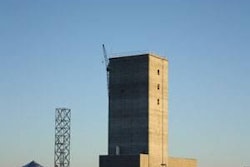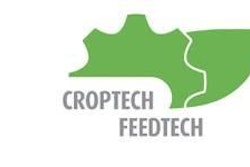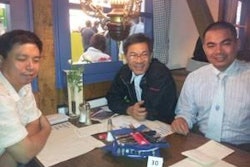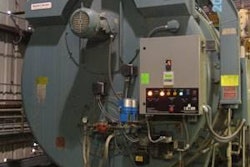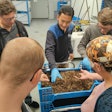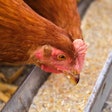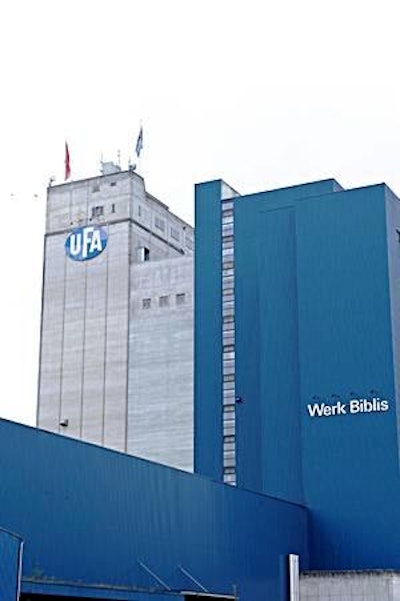
UFA is Switzerland’s largest animal feed producer, with feed production sites in Herzogenbuchsee (300,000 metric tons annually), St.Margrethen (90,000 metric tons annually), Sursee (85,000 metric tons annually), and Puidoux (70,000 metric tons annually). Its finished product is marketed in the form of either expanded or pelleted feed.
Over a 10-year period, the average electrical energy requirement for UFA mills was cut by about 4 percent, while thermal energy consumption was reduced by 10 kWh/t. This was accomplished while increasing the upgrading degree from 60 percent to 100 percent. All feed produced in the UFA facilities is thermally hygienized.
The measures taken at the UFA plants can be implemented at other feed mills that are seeking to increase their energy efficiency.
Biblis plant, Herzogenbuchsee
The Biblis plant was constructed in 2001-02 and was energy-efficient from the start. A multi-stage grinding system using two-pass crushing mills and vertical-rotor hammer mills reduced the energy requirement by about 30 percent in comparison to a direct grinding system.
Since it went into service, the following measures for enhancing energy efficiency have been implemented:
• The exhaust air of the compressed-air generators and blowers is used for the flake dryers and for blowing hot air into the thermal systems for drying. These and additional measures result in savings of 120 MWh of natural gas per year.
• Smart control of the compressed-air generators and a pressure band reduction has enabled savings to be achieved on the order of 0.5 GWh of electrical energy per year.
The following measures will be taken shortly:
• Installation of a fifth thermal line, equipped with a Kubex T9 pellet mill. These new-generation pellet mills have direct drives and their motors have an energy efficiency exceeding 95 percent. They are water-cooled, and losses due to gearings or V-belt drives have been entirely eliminated. This will allow electrical energy savings of 20 to 30 percent compared to conventional pellet mills.
• Application of differential-pressure controllers on the large dust collection filters. These enable the purge-air requirement for cleaning the filter bags (sleeves) to be slashed. The pay-back time of this investment is a mere few months.
St. Margrethen plant
The St. Margrethen plant was rebuilt in 2006-07. The post-grinding system in this plant is equipped with a pre-screening stage ahead of the vertical-rotor hammer mills. This combination cuts the energy requirement by about 20 percent in comparison to conventional horizontal hammer mills. Frequency converters allow the grinding texture of the feed to be adjusted during ongoing production and markedly reduce the starting current.
Since it went into operation, the following measures have been taken to increase energy efficiency:
• The exhaust heat of the compressed-air generators and the flash steam of the condensate separation system of the steam boilers are used for preheating the feedwater. This cuts annual natural gas consumption by 210 MWh.
The following measures will be taken shortly:
• Application of differential-pressure controllers on the large dust collection filters, which slashes the purge-air requirement. The pay-back time of this investment is just a few months.
Puidoux plant
The Puidoux plant was constructed in 1993 and expanded in 2010. The factory was acquired by UFA in 2005. In 2010, a third thermal line including a HYSYS pelleting system was added.
With the expansion, the following measures for cutting energy consumption were taken:
• Installation of a Capstone C65 micro-gas-turbine for generating electrical energy, with a maximum (net) output of 60 kW. The 300-degree Celsius hot exhaust gases are first used for heating the feedwater for the steam boiler and then for heating the water for the building’s heat. The entire residual heat contained in the hot exhaust gases is mixed with the turbine cooling air and the ambient air. It is then blown as hot air into the thermal systems for drying. This system configuration allows nearly 100 percent utilization of the fuel.
• Installation of low-pressure-purged dust collection filters with differential-pressure controllers for the pellet coolers. The purge-air blower is equipped with a frequency converter, and it supplies only that amount of compressed air that is currently needed by the one to three filters, which can be activated and deactivated as required.
• Cooler fans have been provided with frequency converters. This markedly reduces the starting current and allows energy-optimized operation as a function of the ambient temperature.
The following measures will be taken shortly:
• Installation of a multi-stage grinding system using two-pass crushing mills and vertical-rotor hammer mills, which will reduce the energy requirement by as much as 30 percent in comparison to a direct-grinding system. The grinding texture can be automatically controlled by the process control system to meet the specific animals’ needs.
Sursee plant
Built in 1965, the factory in Sursee is the oldest of the four feed mills operated by UFA. In 2007, it underwent a total overhaul and was equipped with a state-of-the-art process control system allowing unmanned operation.
A Bühler standard control system was chosen as the basis of the new control system. However, one challenge was to program the control system for unattended nighttime operation. UFA’s specifications were as follows: the mixing line and the pellet mill and expander line were to produce feed automatically during the night shift, which meant that the control system of the plant would move to a secure mode in the event of faults; the system would automatically acknowledge and correct any faults detected; and the system would have to be able to ensure plant and personnel safety at all times.
Lastly, the new control system would need to alert the standby staff via SMS in case of unplanned incidences, and remote maintenance would also need to be possible. In unmanned operation, the control system would make the decisions that were otherwise made by an experienced operator. In order to enable it to do this, the system had to be able to receive large volumes of information from the sensors and respond according to defined instructions. Ultimately the control system would also enable energy-efficient operation of the entire plant.
With the expansion, a multi-stage grinding system was installed which uses two-pass crushing mills with pre-screening and intermediate screening ahead of the hammer mill. Similar to the Puidoux plant, this should cut energy requirements by about 30 percent as opposed to a direct-grinding system.
UFA initiatives
In order to further reduce energy consumption and to spare the environment, UFA continuously adapts its feed mills to the latest technological knowledge. For example, over the past 10 years about 5 percent electrical energy and 17 percent thermal energy per metric ton of animal feed produced have been conserved, while at the same time increasing the upgrading degree from 60 percent to 100 percent. In addition, UFA now does the following:
• Combined heat and power generation. Utilization by combustion of the energy that is chemically stored in the energy carrier for generating electrical power as the highest-value form of energy improves the calorific value of the heating oil by a factor of about three compared to pure steam generation. This so-called “combined heat and power generation” process substantially increases exergetic efficiency. This means that the chemical potential contained in the fuel (heating oil, natural gas) is exploited almost to the physically possible limit, since electric power is generated beside heat.
• Use of exhaust heat. Instead of blowing the heat exhausted by the air compressors into the atmosphere as exhaust heat, it is systematically utilized for preheating the boiler feedwater or operating hot-air heat exchangers instead of using steam. Together with other heat recovery measures, this systematic utilization of exhaust heat alone enabled UFA to save a total of about 880 MWh of thermal energy in 2011. In addition, approximately one GWh of electric power was saved by efficiency-improving measures.
• Energy-efficient motors. UFA today only procures electric motors of the energy efficiency class IE3 according to IEC 60034-30 or higher.
Comprehensive energy management
UFA has a comprehensive energy management system in place, which ranges from saving power by using a staircase lighting control system (5 MWh/a) to refurbishing entire plants. This has allowed the UFA factories to discharge 500 fewer metric tons of CO2 into the atmosphere in absolute terms than in 2008, while increasing their volume by 10 percent. In all, some 3,100 fewer metric tons of CO2 were emitted into the environment in 2011 than would have been if development had continued unchecked. Thanks to the targeted reduction of carbon emissions, UFA is exempted from paying CO2 duties on fuels and is allowed to carry the Swiss CO2 Label.
